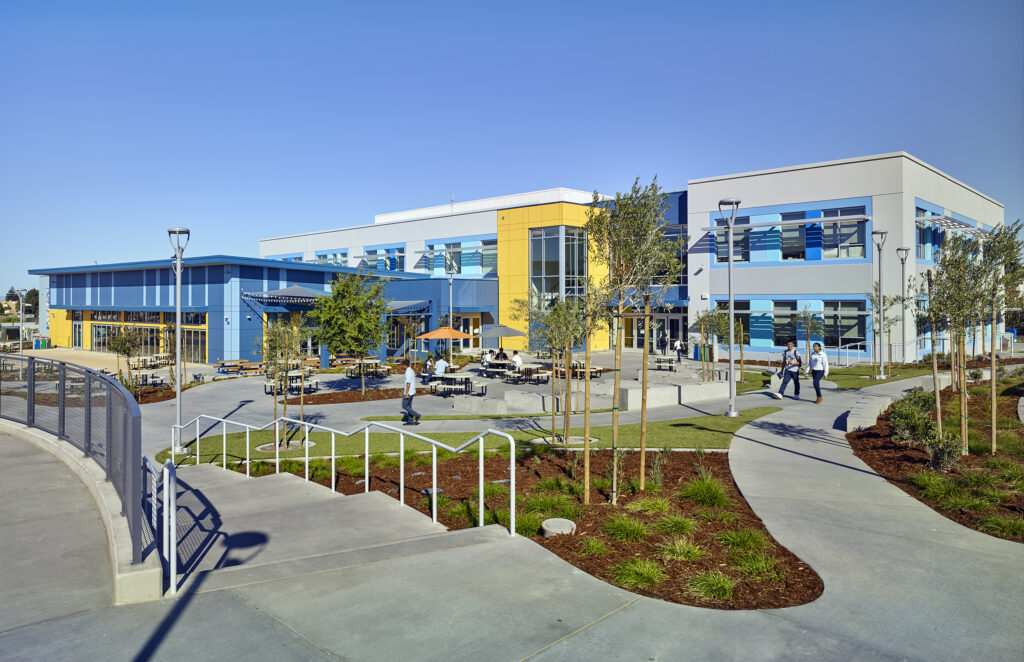Making Waves Academy, a charter school in Richmond, tries to instill a college-pursuing attitude while leaving room for kids to enter a career after graduation if they wish.
Courtesy: Making Waves Academy
There is a troubling trend in California that makes affordable and quality higher education — which is meant to be a public good — not even an option for most students, particularly Black and Latino students. It’s the inequity of students completing the “A-G” courses required for admission to the University of California and California State University systems. More than half of all students, and over two-thirds of Black and Latino students, did not meet these requirements — too often because the courses were not offered or the students didn’t know they were needed. This means they are ineligible for admission into California’s public universities.
As CEO of a grade 5-12 charter school in Richmond, I believe the A-G requirements should be seen as an asset rather than an obstacle for California schools. The requirements are transparent and attainable. They help prepare students academically, support eligibility for California’s public universities, and open up a variety of opportunities for students’ future career pathways. Ultimately, this helps alleviate inequities in education, the workforce and the economy.
At our school, our goal is that 100% of our students are ready for college while also embracing, supporting and celebrating students who want to pursue early post-secondary career options. Within the Class of 2024, 95% of our graduates are pursuing higher education, and within that group, 71% are planning to attend University of California or California State Universities campuses. Among our 1,000 or so fifth through 12th graders, 99% are students of color, and 85% are from socioeconomically disadvantaged backgrounds.
Here is how school and district leaders can build a culture around supporting students in meeting the A-G requirements.
Align your curriculum to the A-G requirements
Students don’t know what they don’t know. And they don’t always know there are specific course requirements to be eligible to attend public universities. It is our responsibility as school leaders and systems to align our curriculum to the A-G requirements and remove that burden on individual students.
The good news is that this is not a very heavy lift. In California, students are already required to take a variation of core academic subjects listed within the A-G requirements, such as English, history, science and math. Making sure students are taking a lab science class, a third year of a world language, or a math up to Algebra II are small but meaningful adjustments to their course schedules that would help more students meet the A-G requirements, thus meeting eligibility requirements for UC and CSU campuses.
Get creative to track individual students
For every college and career counselor in California, there are 464 students. It’s no wonder 56% of California students experience barriers to meeting the requirements. Instead of relying solely on counselors, make the most of advisory period. Advisory period teachers can reinforce college readiness and help track individual students’ progress on the A-G requirements. Our advisory teachers track the same cohort of students from ninth through 12th grade. With this support, students can also practice their agency by being actively involved in mapping out their courses and paying attention to their post-graduation plans, which serves them well whether they ultimately pursue college or not.
Be inclusive of non-college-going students
It is important to note that a culture that embraces the A-G requirements and college readiness and a culture that embraces a continuum of college and career options can and should live side by side. It is a both/and approach not an either/or approach. Allow for both. When you align to the A-G requirements, you ensure that students meet the “floor” for college eligibility. Build further understanding with students on the continuum of attainable pathways. For example, the A-G requirements can also align with career technical education, which integrates core academic courses with technical and occupational ones. This way, students can explore career interests and still remain eligible for college. Knowing the range of options available means students can choose what’s best for them.
Communicate early and often with parents and families
California has some of the world’s best and most affordable opportunities for higher education. Tragically, many students and families don’t know these opportunities are attainable. The importance of the A-G requirements and information around college affordability must be communicated to students and families early and often. Ideally, regular updates and information sessions start with students and families in middle school. For example, we set clear expectations with students and families at fifth grade orientation. We talk to them about the A-G requirements being built into our curriculum and about our school culture around college readiness. Time and time again, we see ecstatic students and families when they realize college is accessible and attainable.
It’s our responsibility as school leaders or school systems to provide the necessary courses and support to bridge the inequities between high school to college and careers. The logistical challenges are surely outweighed by the opportunities: more racial representation in higher education, an increase in economic mobility for students from low-income backgrounds, and a more diverse and educated workforce.
•••
Alton B. Nelson Jr. is the CEO of Making Waves Academy in the Bay Area city of Richmond.
The opinions in this commentary are those of the author. We welcome guest commentaries with diverse points of view. If you would like to submit a commentary, please review our guidelines and contact us.

